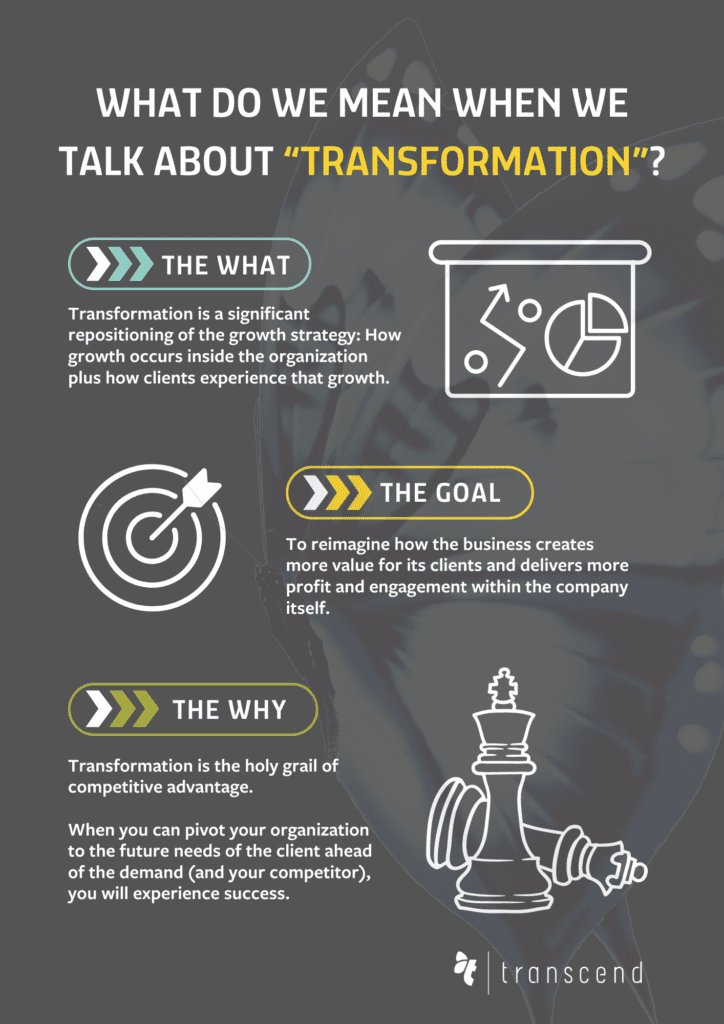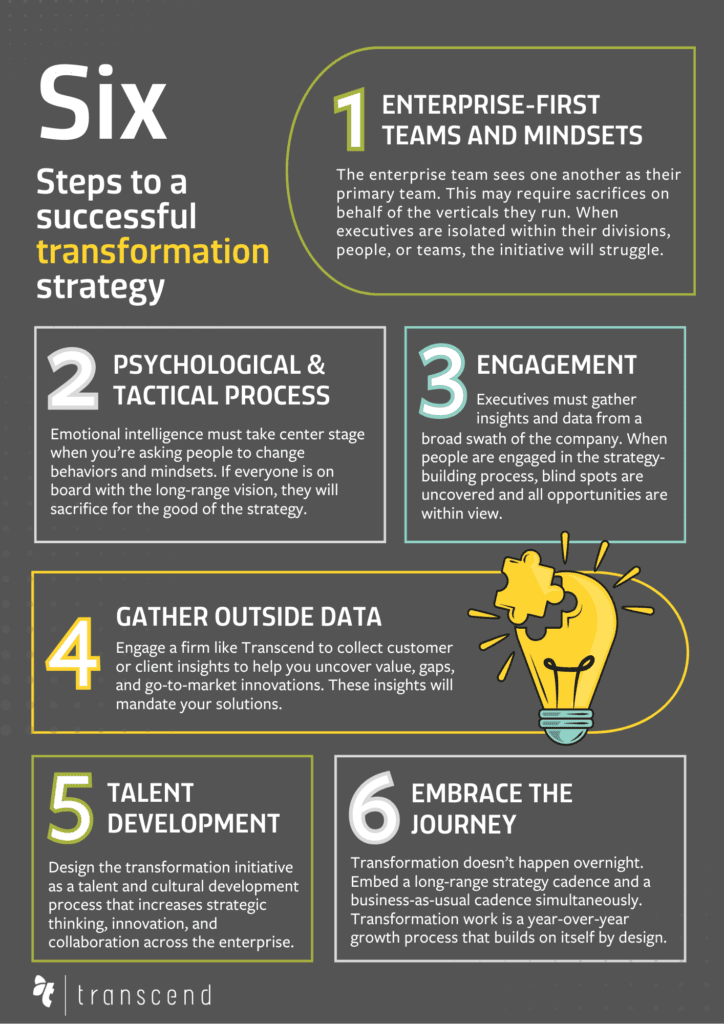
And Why It Takes More Than Change Management
More than a third of large organizations have a transformation program underway at any given time. Global spending on digital transformation alone is expected to hit 3.4 trillion dollars by 2026.
Given the mountain of resources going into these endeavors, you may be shocked to learn that only 12% of all corporate transformation initiatives succeed as designed.
It’s safe to say enterprise transformation—or, more likely, its impending failure—is keeping many CEOs up at night. But it doesn’t have to. CEOs can leverage the transformation process to reinvent how their people and teams are engaged and accountable in planning and executing business strategy, creating an ecosystem of strategic performance and success.
Our August 2024 webinar, Managing Change vs Leading Transformation, features a team of experts offering a playbook for driving accelerated growth through transformation and how to avoid common pitfalls along the way. In this article, we’ll outline key concepts from the webinar that CEOs and executive teams can embed within the planning and execution processes of their transformation initiatives to ensure long-term success.
The Transformation-Ready Culture:
Key Differences Between Managing Change and Driving Transformation
Executives view transformation in a myriad of ways. For Transcend and our clients, transformation is a significant repositioning of the company’s growth strategy to deliver greater client value and increased profit. In other words, it’s materially changing what a business does and how it does it to increase the value for all stakeholders and shareholders.


Executives and teams are typically experienced and comfortable managing everyday change. Change management can exist within people, technology, products, or go-to-market tactics individually, without an overarching transformation effort. However, if change is taking place within two or more of these areas simultaneously, it will alter how the enterprise functions and warrant a transformational change approach.
The risk of a failed effort resides in the strategic integration across multiple elements of the business that may have different motivations, investment needs, resourcing capabilities, and/or perspectives on how to drive growth.
Therefore, the execution of transformational efforts is as much a strategic and tactical growth process as it is a relational and emotional management process. It necessitates a high level of alignment, new behaviors and mindsets, and creative execution.
The intersection of conflicting individual, team, and enterprise needs is where the best-laid transformational plans stall and ultimately fail. To combat this, executives can initiate a balanced execution approach that aligns teams with speed and empowers shared ownership across the enterprise. With so few teams delivering timely and accurate strategies, a well-executed transformation is the holy grail of competitive advantage.
How to Identify the Need for Transformation
Strategic leaders must learn to identify the need for transformation within their companies before they can act on it.
Now more than ever, organizations need to institute proactive vs. reactive transformation. In fact, ensuring a proactive approach is the single greatest responsibility of the CEO and executive unit. They can do this by assessing the needs of the market and continually serving those needs and opportunities with innovation.
Responding reactively incurs more risk, often misses the window for consumer demand, and requires greater speed to delivery. That being said, there may be times when market innovation or technological advancements simply outpace business, and reactive transformation is the remaining option.
Executives experiencing the following are likely on the edge of a reactive transformation experience that can’t be solved with vertical strategies alone.
- Business growth is becoming more difficult with your current go-to-market strategy.
- You are losing market share due to competitor innovations or growth.
- The market demand exists, but the business has an inability to produce and serve the demand.
- Cost savings measures are stripping away resources and expertise needed for future investments.
- The business is thriving due to acquisitions, but organic growth capabilities and business results remain limited.
- The business has an overreliance on key customers, distributors, suppliers, or leaders that can shift the trajectory of the company overnight.
- The business lacks an AI strategy focused on efficiency, data, and innovation.
How to Lead a Transformational Strategy
Here are six steps CEOs and executives can take to ensure the successful origin of a transformation strategy:


Keys to Implementing a Transformational Strategy
Once the strategy has launched, it can be challenging to execute while maintaining the everyday needs of the business. Many companies have a lean business structure that makes it difficult to lead business-as-usual (BAU) and transformational growth implementations simultaneously. However, the CEO and executive team must ensure a cadence that can keep both elements of the business center-of-desk. For CEOs, this means the transformation planning, rollout, pace of execution, internal communications, and client messaging should become their primary focus. There is no other role in the company that can reinforce or sink a transformational process like the CEO. Most transformation initiatives fall short because CEOs are conflicted, distracted, or have an inconsistent focus on the future of the business.
The CEOs Platform for Leading Transformational Change
CEOs leading transformation must leverage new tools and processes to guide their messaging, intervention, and investment strategy. This will become the CEO’s leadership platform for the duration of the transformation process.
1. The transformation strategy itself.
This is the specific roadmap of actions, priorities, and ownership teams driving the transformational strategy forward. The success of the enterprise and transformation effort will be determined by the CEO’s engagement in monitoring, resourcing, and reinforcing the execution of the plan as designed.
2. A reimagined and redesigned leadership cadence.
For BAU and new transformational processes to succeed, two simultaneous executive cadences will need to be adopted. First, CEOs must continue their traditional BAU cadence. Empowering decision-making within the organization will make this more focused and streamlined, opening up time for a second cadence centered on transformation.
For the transformation to succeed, the CEO will need to adopt a monthly and quarterly meeting structure to tackle unique execution needs. These provide teams the opportunity to share lessons learned, execution roadblocks, client insights, and strategy realignment. In addition, the CEO can keep a pulse on milestones, adoption, resource allocation, and future investment decisions.
This cadence avoids a common transformation failure point: collaboration gaps of three or more months. Sustaining execution momentum and focus within transformation is essential because change efforts face more technical and human roadblocks than BAU collaborations and deliverables. A stalled or underperforming transformation effort can likely be traced back to the execution cadence that is kept and reinforced by the CEO.
3. Proactive talent capability and capacity planning.
Transformation is not possible without talent. Set your talent up for success by ensuring they have the capabilities and capacity to do the work. As a first step, bring the HR leader to the table. This is critical to understanding how the tension of transformation will affect talent and culture.
Many transformations fail because roles don’t shift to meet the new work and talent capabilities they demand. The organizational structure needs to be reviewed, and the roles within that structure changed to coincide with the new strategy. The CEO will need to invest in talent with a growth mindset in order to minimize capability blind spots and create a solid foundation for the transformation to succeed.
4. Continuous reprioritization of priorities, processes, and capabilities.
Leaders must be rigorous about day-to-day actions they can let go of and pivot toward current transformation efforts. For instance:
- Are there tasks that can be delegated or that are no longer necessary?
- How can the business deliver what is needed by empowering underutilized resources or realigning talent?
- What expertise is the business simply lacking that is making it harder to maintain the business? How can this be solved to elevate leadership time and focus?
- What are the current projects or antiquated practices that need to be paused or reassessed because of their incremental impact on the future of the business?
For transformation to succeed, these processes—and the strategy itself—must become the foundational platform for the CEO and executive team. Continuous conversations, a rigorous executive meeting cadence, and healthy debate must be fully present to ensure transparency and decision-making at speed. Nothing from the past is sacred during transformation efforts—everything is on the table for evaluation and adjustment.
How to know that you’ve achieved transformation
- Top and bottom-line growth.
- Lifts in enterprise agility, decision-making capabilities, and strategic acumen.
- Talent retention and engagement.
- Increased BAU innovation and real-time client/customer outcomes.
- Market penetration and expansion.
- New capabilities and capacity realized where it matters most to the future of the business.
Are you ready for transformation?
You might be more ready than you think. Most CEOs underestimate the capability and capacity of their teams—and themselves—in leading transformation. When the business environment becomes synergistic, people and teams shine in ways that never seemed possible. Their purpose becomes stronger, and engagement soars.
As you begin your transformation journey, remember two important takeaways:
1. Strategy can’t be a check-the-box activity. The key to success is creating a living, breathing strategy that can grow and change with the business’s needs.
2. The best strategy without execution is just a plan. For your strategy to be a success, you need the right leaders in the right roles operating at a high level of readiness.
Transcend deploys tactical and executive performance resources that have increased the speed of enterprise transformation by an average of 40%.
To ensure your transformation is part of the 12% that succeed, contact Transcend, and we will connect you with our strategy experts. You can watch the webinar this article is based on or reach out directly to the speakers of this month’s webinar here.
Our webinar series, “How Executives Drive Lasting Transformation,” continues September 24th, 2pm ET / 11am PT on LinkedIn Live. This time, we’ll discuss how to assess your company’s strategic readiness. Register here.

